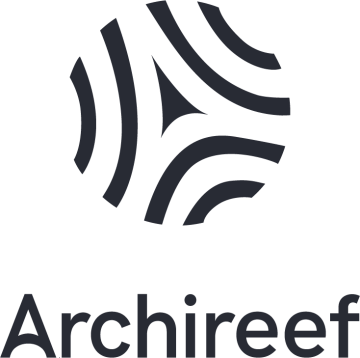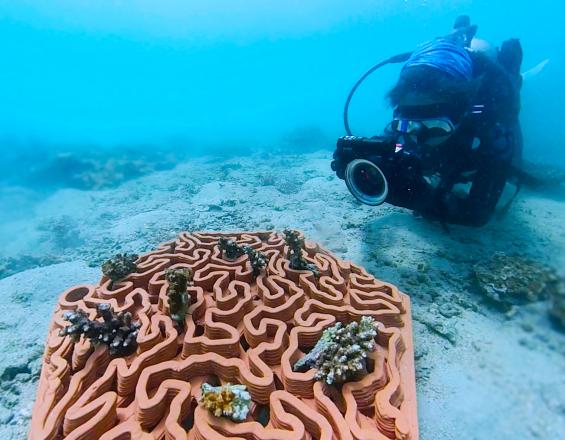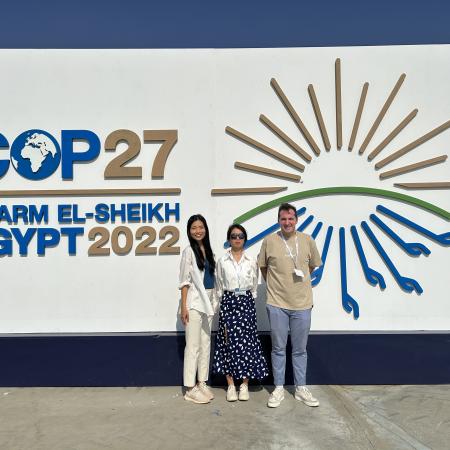
World's First 3D-printed Reef Tiles in Terracotta

Recently named one of the "Forbes Asia 100 to Watch" startups, Archireef Limited is a green tech company that leverages marine biology, material science and the latest technologies in 3D printing to create the world's first 3D printed coral reef tile in terracotta, a truly ocean-friendly material. Featured by CNN, CBS, SCMP, Tatler and other international as well as local media, our reef tiles deliver a proven 4 times effectiveness over conventional methods, securing a 95% coral survivorship.
Contexte
Challenges addressed
Coral reefs are carbon sinks, meaning that they can sequester and store carbon. As the deadline is approaching, it has become increasingly popular for nations and policy makers to start looking for relatively new methods to achieve their carbon removal and 1.5 degree goals. One of the methods is to account for carbon sinks in countries' carbon budget. Coral reefs are therefore viewed as natural capital that contribute to global climate action.
Emplacement
Traiter
Summary of the process
Before the deployment of our 3D-printed reef tiles, 3D-printers are used for production at our eco-engineering facility. After deployment, we continuously monitor their impacts using eDNA, quantifying the ecological benefits brought by our projects.
Building Blocks
Environmental DNA
Internationally, coral restoration and biodiversity are still lacking behind in terms of certification and uniform verification / measurement standards. To address this issue, we adopt eDNA - environmental DNA - to measure biodiversity, though in the long run, international standards would definitely increase our recognition and perceived reliability.
Enabling factors
Our Chief Scientist and Co-founder Dr David Baker is also an Associate Professor of Ecology and Biodiversity at the University of Hong Kong, as well as a multi-disciplinary marine ecologist with a focus on coral reef species. He leads our scientific team to develop a robust methodolgy to measure and monitor the impacts of our restoration work using science-backed methodologies such as eDNA.
Lesson learned
eDNA approaches require much less effort in terms of human resources and time. Water and sediment samples can be procured easily, and stored indefinitely. Data analysis does not require any special taxonomic expertise. It is therefore presumed that eDNA biodiversity monitoring will become the norm in the future, once good regional databases for biodiversity are established.
3D-printing
Archireef leverages the latest technologies in 3D printing to create artificial habitats that are truly ocean-friendly. With the algorithm-based adaptiveness and 3D printer’s versatility, our reef tiles have been proven 4 times more effective in keeping the corals alive than conventional methods, securing 95% of coral survivorship.
Enabling factors
Most, if not all, players in the coral restoration industry involve the use of harmful materials such as concrete blocks and metal rebars. We use clay, which is a truly ocean-friendly material that is non-toxic to the ocean. We are also able to tweak the design of our biomimicry pattern based on the growth form of local species, allowing a 4X higher effectiveness in restoration success.
Lesson learned
With full control over our R&D (via a hub in Hong Kong) and our production (via a facility in Abu Dhabi), we have established a strong basis for both new product development and full scale commercialisation. With this in mind, our 2025 goal is to expand our footprint to 10 large restoration sites across the Atlantic, Pacific, and Indian Oceans.
Impacts
Coral reefs are not only beneficial to costal communities and divers - they are home to 25% of marine life and are therefore integral to biodiversity. For now, we are focusing on corporates who have an emphasis on ESG and biodiversity and are open to innovative solutions. Thanks to the extensive media coverage that we have enjoyed so far, for instance, CNN in Hong Kong, CNN in the UAE, World Economic Forum, our clients actually reached out to us!
Coral survivorship is one of our key impacts and it depends on an array of factors from site selection to deployment methodologies and post-deployment check-ups. We also have a strong emphasis on social impact as we are a human-centric company. We try our best to amplify project impacts by always integrating education to both adults and children into our work and so their feedback is another key success indicator of our work.
Beneficiaries
Apart from restoring coral reefs, we hold workshops for schools and corporates. After deployment, we monitor and deliver quantifiable ecological impacts using science-backed methodologies that can be integrated into clients' ESG reports.
Sustainable Development Goals
Story

Our CEO and co-founder, Vriko Yu, grew up in Hong Kong’s countryside. When she was young, she spent a lot of time around the ocean. She got her diving license in college, and that opened a new world. Hong Kong is incredibly biodiverse - Hong Kong waters cover only 0.05% of China’s marine areas, but we can find more than 25% of the total marine life recorded in China. In 2014, she witnessed a large-scale bleaching event, which then led to the disappearance of a small patch of coral communities in just two months. That inspired her to think outside of the box, combining innovation and marine ecology to save coral reefs. We have been incredibly lucky in our journey. Apart from restoring reefs in Hong Kong, we have been invited to bring our solutions to international platforms for the likes of COP27 in Egypt and World Economic Forum's Annual Meeting in Switzerland.







